Your Guide to a Complete Almond Nutrition Program
January 20, 2022
Thanks for tuning in to our Almond Fertility Program Webinar! Andrew Pedersen, who has years of experience working with almonds, has put together his recommendations for secondary and micro nutrients based on his experience and trial work with almonds.
What You’ll Learn
- What micronutrients are important to almonds
- What role each micronutrient plays in almond production
- When to apply micronutrients to almonds
- A better understanding of foliar micronutrient technologies
- Which products can help you accomplish your micronutrient goals
In the video above, Andrew will walk you through each growth stage for almonds. Below, you’ll find a summary of the information as well as some other helpful tips and tools.
Questions?
If you have any questions at all about this information presented to you, BRANDT is always glad to help. Click or tap the button below to get in touch with a BRANDT expert.
Do you think BRANDT’s products are the right fit for your operation? Click or tap the button below to find a retailer that sells BRANDT products near you.

4 Goals for Almond Fertility
We've broken this almond fertility program into four goals that an almond grower should try to accomplish to optimize yield and set up the tree for a good yield next year. Within each of these goals we're going to focus on the role various plant nutrients play during those stages of crop development.
- Pollination – Improving pollen viability, flower health, and disease resistance with foliar applications
- Nut Retention – Kickstarting photosynthetic production, nitrogen utilization, and root growth with foliar and fertigation applications
- Kernel Sizing – Maximizing potassium uptake, and maintaining carbohydrate production and nitrogen conversion
- Bud Development – Loading fruiting and vegetative buds with nutrients that will enhance nut set and early growth next season
Pink Bud Timing
Boron, Calcium, and Zinc are all important for flower development, disease resistance, and pollen viability.
Boron products should preferably be applied at or before 10% bloom. Pink bud boron spray is especially beneficial if no post-harvest foliar boron was applied the previous growing season.
Products and Timing for Pink Bud
- BRANDT Smart B 1 pt/a (5% B)
- BRANDT Smart B-Mo 1 pt/a (5% B, 0.5% Mo)
- BRANDT Manni-Plex Cal B 1 qt/a (7% Ca, 1% B)
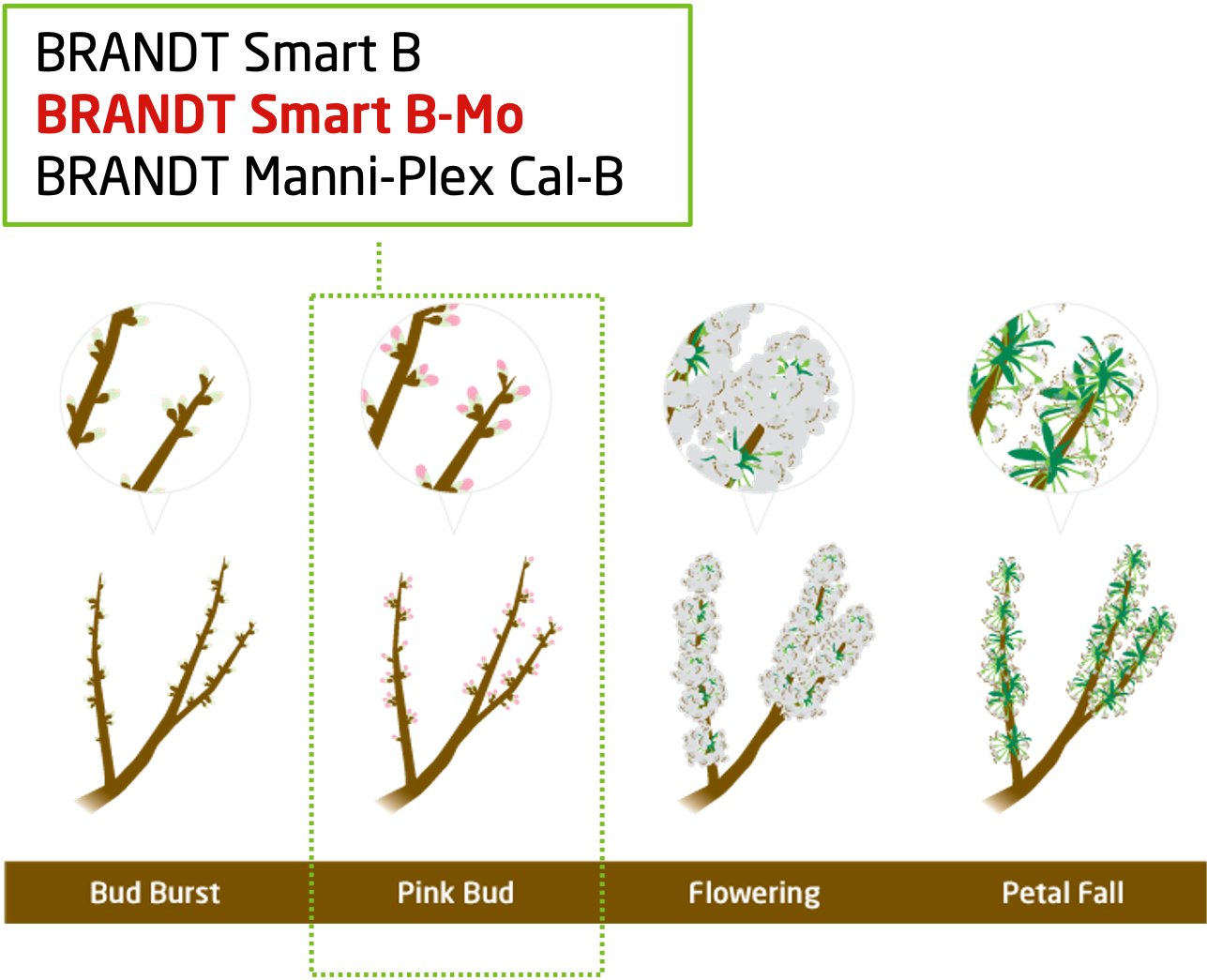
BRANDT Smart B Superior Mobility
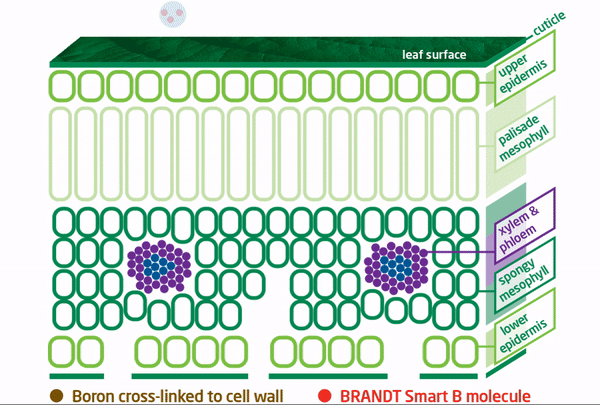
Conventional Boron Tied Up Inside Plant
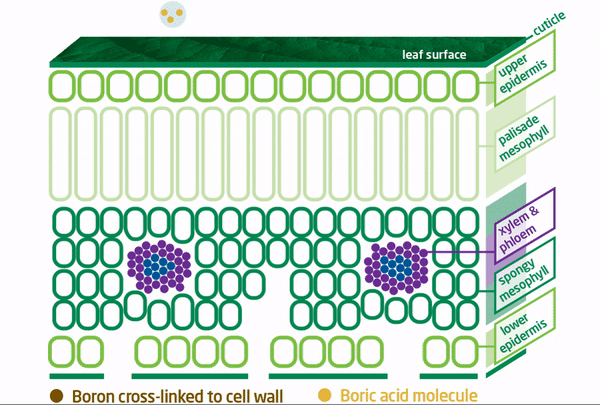
Our Boron Moves!
Typically, once boron has been absorbed by the plant and incorporated into the primary cell walls structures, disassembly, reorganization, and transport of the boron cannot occur resulting in its immobility.
To address this boron mobility issue, BRANDT developed BRANDT Smart B and BRANDT Smart B-Mo to specifically prevent boron from binding with pectins, ensuring that applied boron remains free and mobile for effective travel to plant growth tissues.
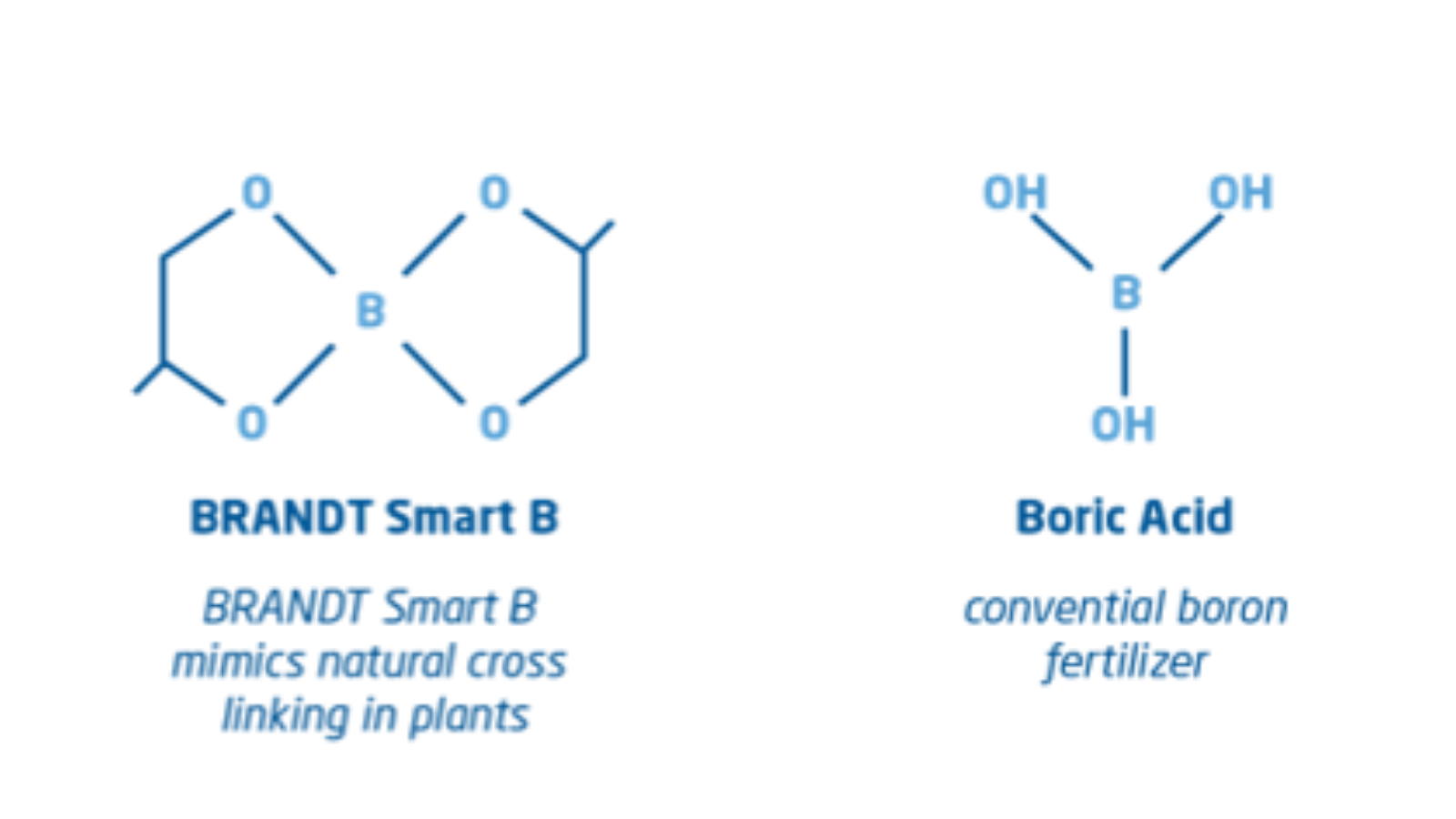
The BRANDT smart boron molecule is cross-linked, which provides a protective “shield” for the boron that significantly increases foliar applied boron mobility. This allows the smart boron molecule(s) access to plant growing points quickly and easily, thereby providing the most benefit.
The molecule structure also allows the formulations to tank mix with other crop chemicals and fertilizers, including calcium, without any compatibility issues.
In contrast, conventional boron fertilizers are not cross-linked with oxygen, which results in less boron availability and less boron at plant growing points
Our Boron Mixes!
BRANDT's Smart Boron products have an acidic pH which when combined with the cross-linked complex, gives these products significant tank mix advantages.
- Highly soluble and stable across a broad pH range
- Boron will not precipitate when it comes in contact with acidic solutions
- Compatible with other micronutrients, including Zn and Ca
- Compatible with insecticides, herbicides and fungicides that have very specific pH ranges
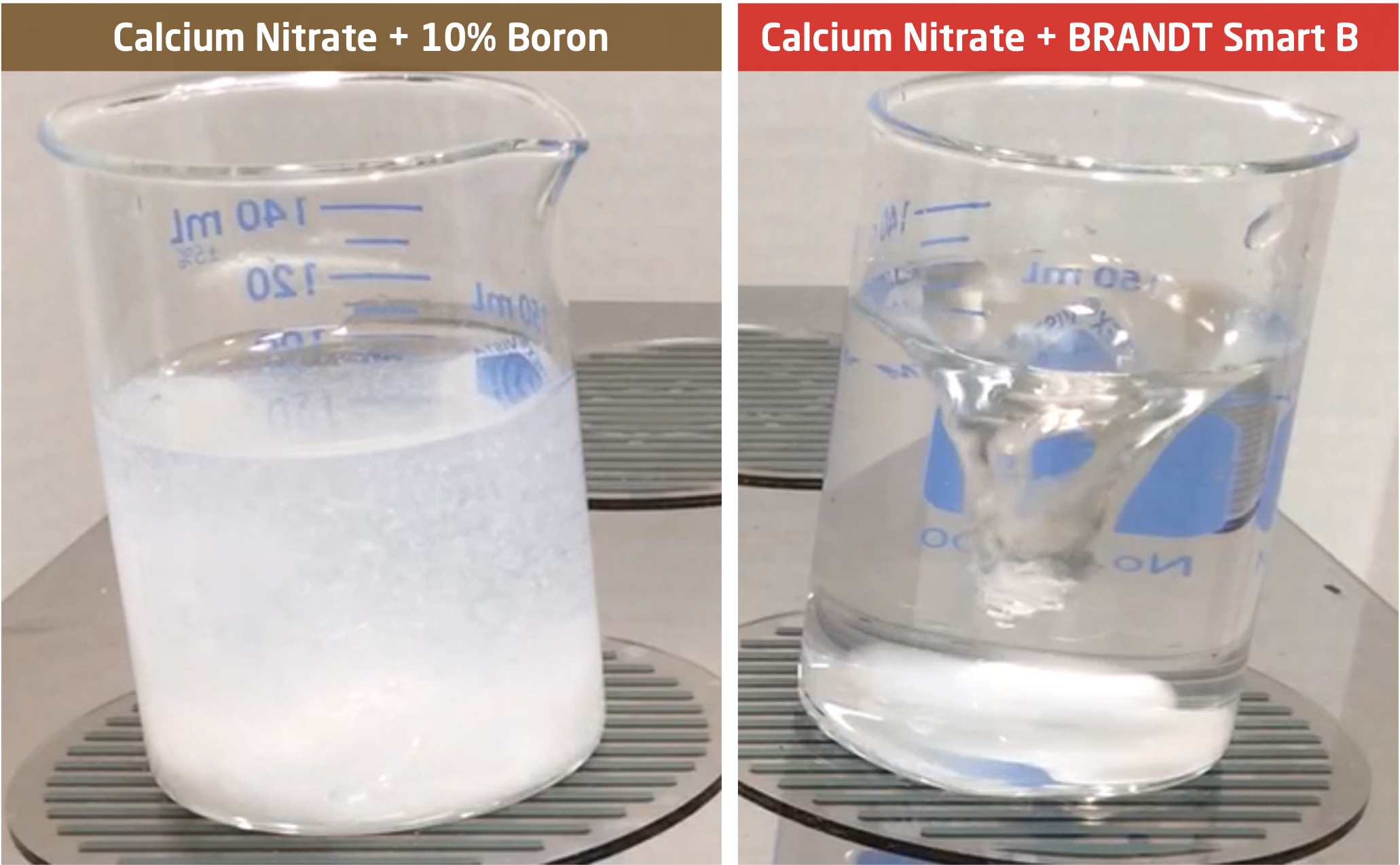
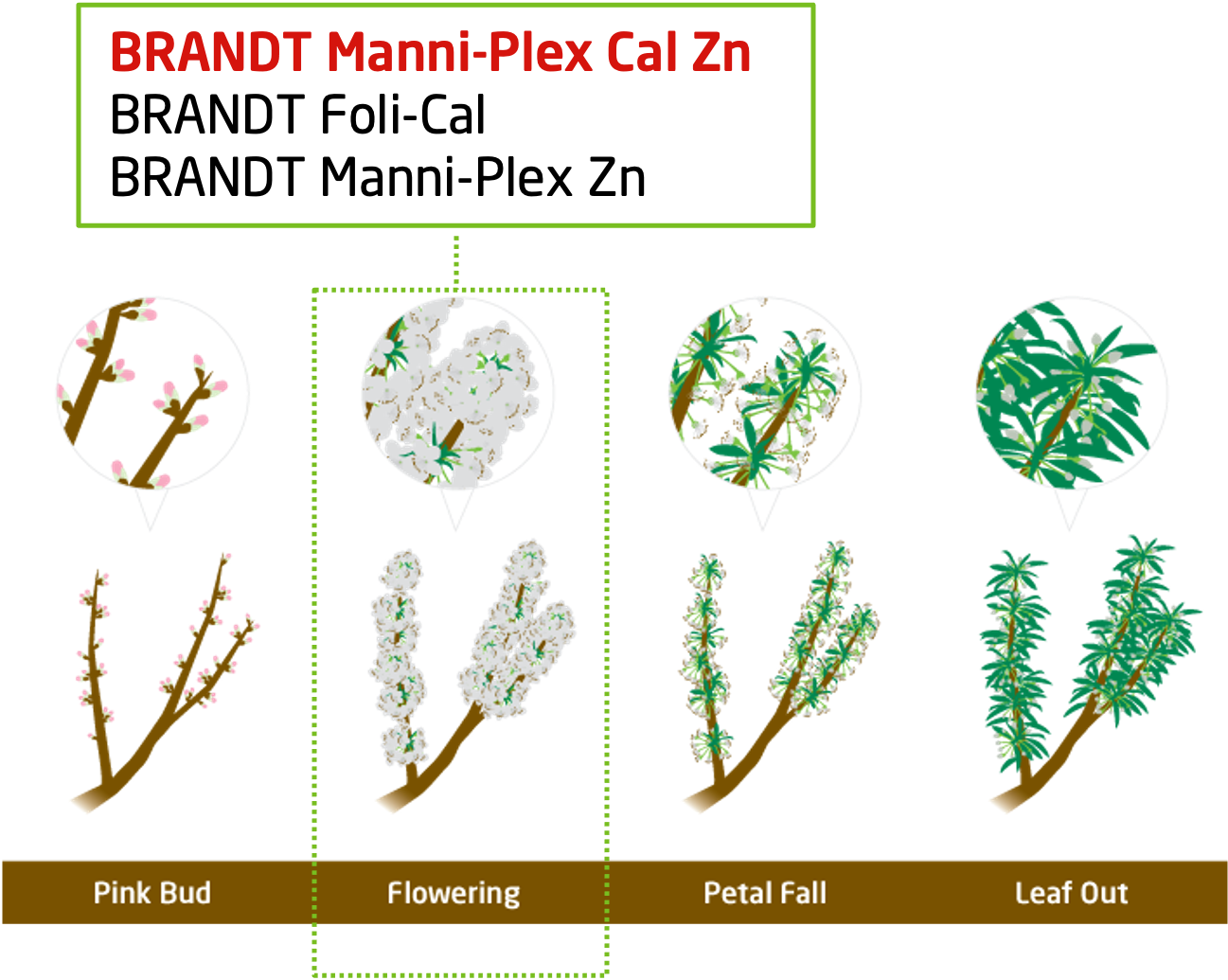
Flowering
During bloom, foliar spray of calcium and zinc can really help with fertilization, and disease resistance to blossom brown rot, bacterial blast and other early spring diseases.
Since calcium has poor mobility in the plant, a foliar spray that directly contacts the flower can be a helpful strategy.
Products for Flowering Timing
- BRANDT Manni-Plex Cal Zn 1 qt/a (6% Ca, 3% Zn)
- BRANDT Foli-Cal 1 qt/a (10% Ca)
- BRANDT Manni-Plex Zn 1 pt/a (7% Zn)
BRANDT Manni-Plex: High Performance Micronutrients
Unlike other nutrient forms, the nutrient elements in MANNI-PLEX formulations are complexed with sugar alcohol. The proprietary complex has a very small molecular size and shape, which allows MANNI-PLEX to enter the plant through small stomata and transcuticular pores on the leaf surface and helps get more nutrients into the plant.
Once MANNI-PLEX nutrients are inside the plant, they move quickly and freely through the phloem to plant growth areas. This allows the plant to fully utilize the applied nutrients, which results in improved plant health and crop production quality.
The correlation of sugar alcohol complexes and nutrient mobility within plants has been validated in University studies. Research showed that plants that were rich in sugar alcohol complexes, such as mannitol, had better distribution of nutrients such as boron from leaves through the phloem and a higher accumulation in fruit tissues.
Nut Retention (Fertigation)
Phosphorus and zinc are important to root growth and energy production. Potassium is important for carbohydrate translocation. Sulfur is important for nitrogen use efficiency.
These applications of EnzUp should go on around end of March or early April during early feeder root flush, to optimize enzyme activity.
Fertigation Products During Nut Retention
- BRANDT EnzUp Zn LS 3 qt/a (4% Zn)
- BRANDT EnzUp P DS 20-30 lb/a (12-58-0)
- BRANDT EnzUp K DS 20-30 lb/a (5-0-49-8S)
- BRANDT EnzUp S DS 5-10 lb/a (21-0-0-23S)
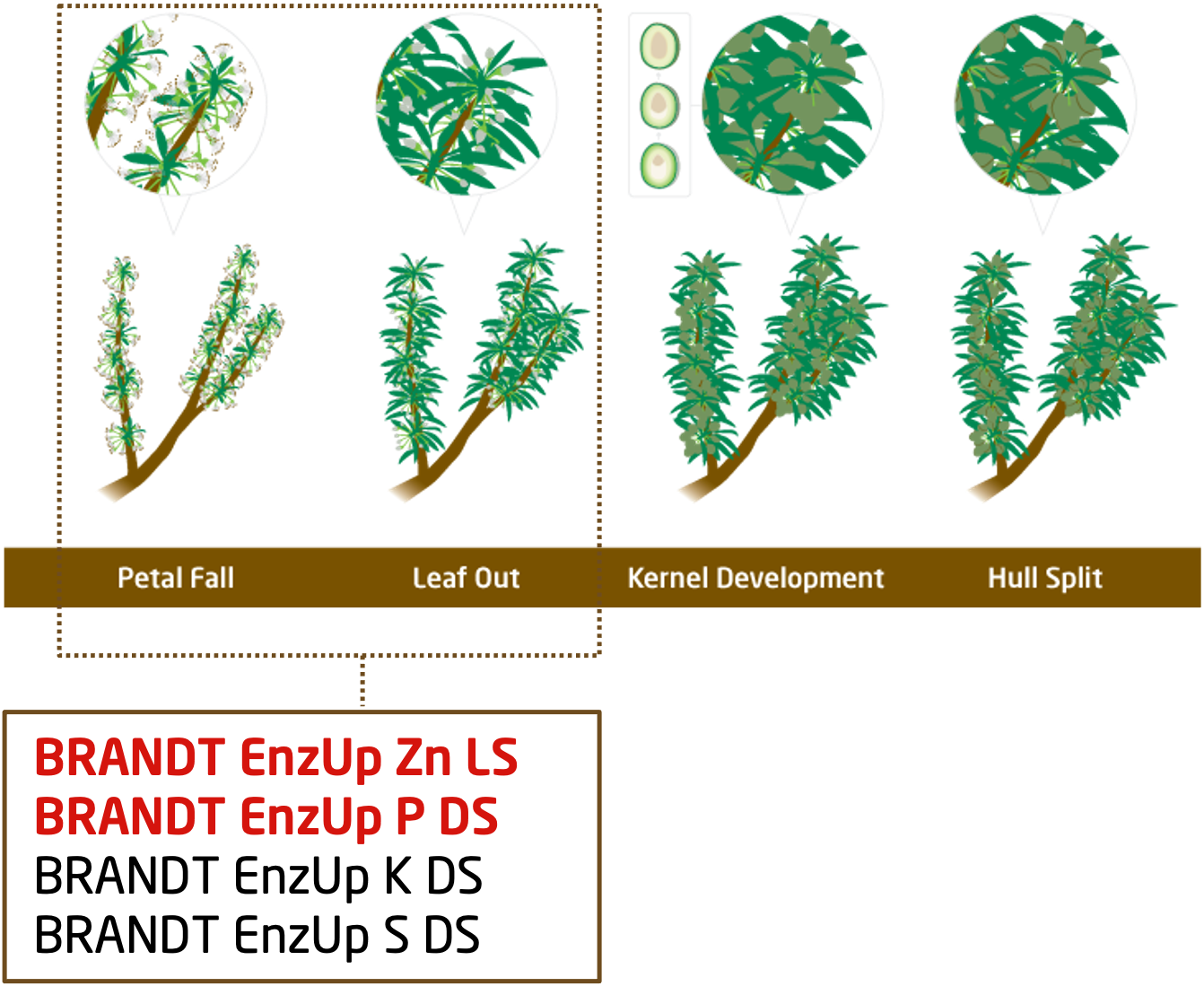
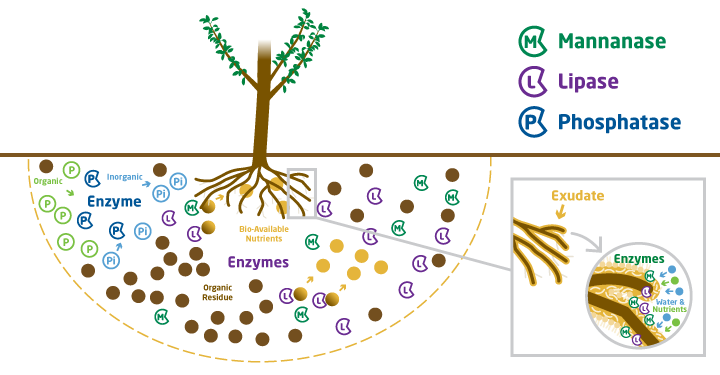
3 Different Types of Enzymes
All of BRANDT's EnzUp formulations utilize one or a combination of the following enzymes:
Mannanase Enzyme
its primary function is to break down starches in the exudate that surrounds the outermost layer of the root tips. This chemical reaction creates a draw of water and nutrients to the root zone and releases sugars to the plant. This in turn boosts root growth and increases microbial activity
Lipase Enzyme
its primary function is to break down lipids in root exudates and organic residue in the soil allowing for better water flow and nutrient uptake by the roots.
Phosphatase Enzyme
its primary function is to convert tied up organic phosphate into soluble, bio-available phosphate that is immediately available for plant use. This reaction significantly increases nutrient availability and uptake
What is BRANDT EnzUp Technology?
BRANDT EnzUp is a groundbreaking new enzyme technology that enhances water and nutrient availability, uptake and use by the roots and increases microbial activity. The result is improved soil and plant health, increased root mass and improved drought and stress tolerance.
What Are Enzymes?
Enzymes are proteins that catalyze biological reactions. In the soil they are produced primarily by microbes and perform many important functions:
- Conversion of organic and inorganic nutrients
- Nitrogen fixation and conversion
- Carbon cycling
- Pesticide degradation
- Organic matter decomposition
Often, enzymes require metallic cofactor like zinc to function. BRANDT ENZUP enzymes undergo a patent pending process that prevents the enzymes from degrading in the soil too quickly after application. This allows them to remain active longer and substantially increases enzyme efficacy. This is an entirely new technology and scientific breakthrough for agriculture.
Kernel Sizing (Foliar)
This period is all about putting size and dry weight on the kernels. Optimizing photosynthesis with Zn, Mn, and Fe, especially if mid April tissue levels were low. Improving nitrogen use efficiency with Zn, Fe, B, and Mo.
This foliar spray is less critical than earlier timings since soil uptake of micronutrients is generally better this time of the season. However, if you are making a “May Spray” it would be good to throw some micronutrients in at this time.
Foliar Products During Kernel Sizing
- BRANDT Manni-Plex Zn 1 qt/a (7% Zn)
- BRANDT Manni-Plex Mn 1 pt/a (5% Mn)
- BRANDT Manni-Plex Fe 1 qt/a (5% Fe)
- BRANDT Smart B-Mo 1 pt/a (5% B, 0.5% Mo)
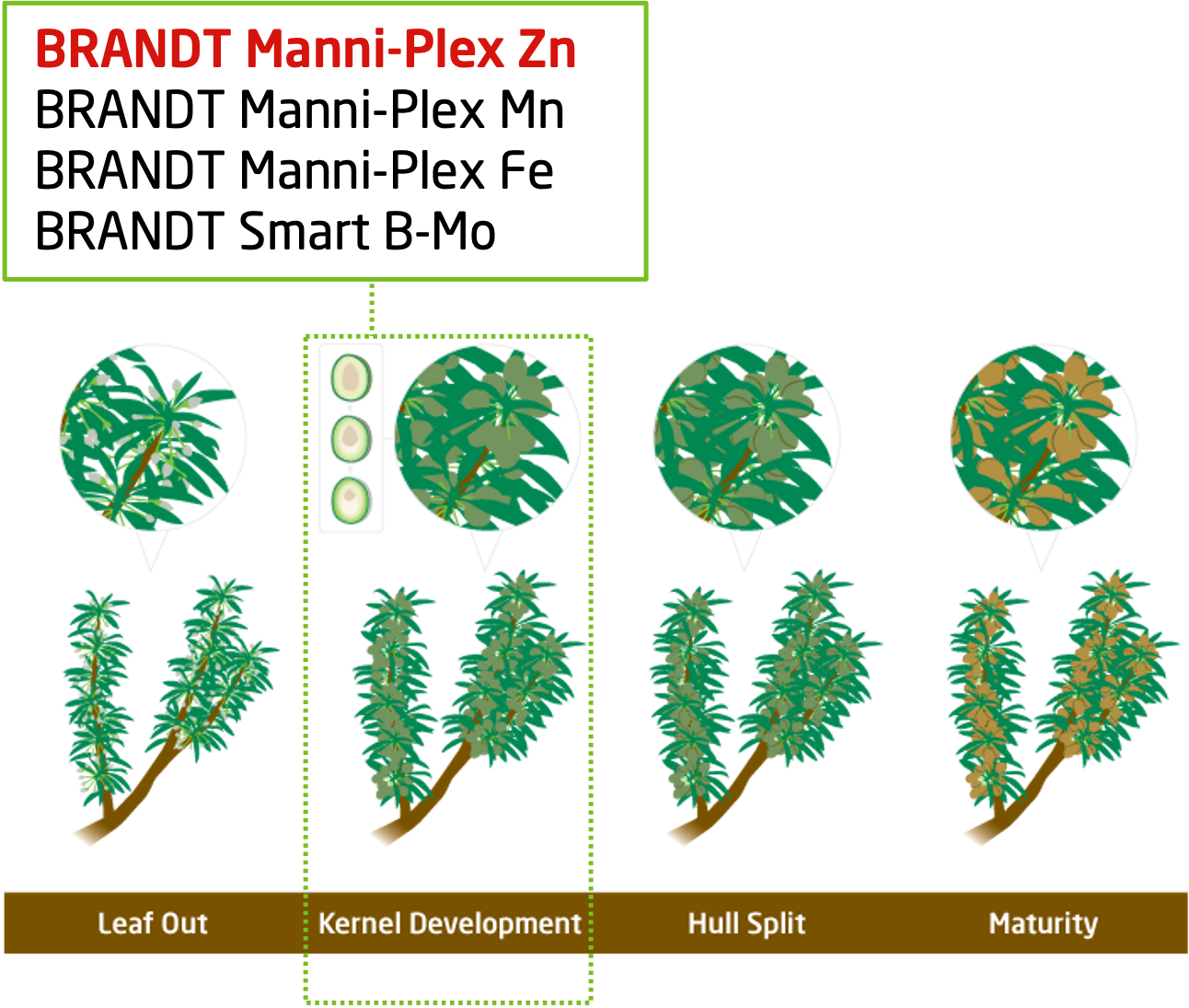
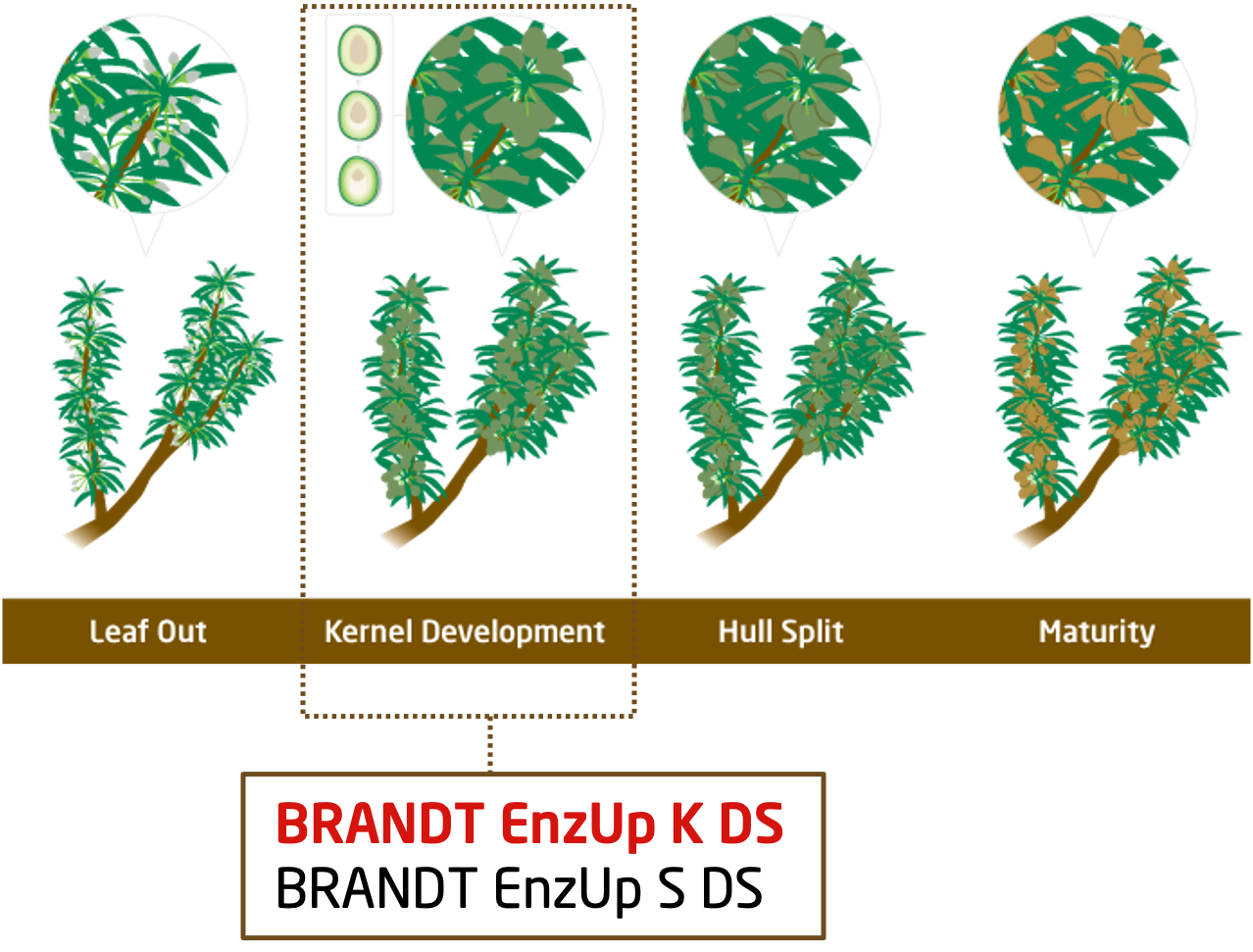
Kernel Sizing (Fertigation)
This period is all about putting size and dry weight on the kernels. Sulfur will help with nitrogen utilization. Potassium uptake during this period is very high. In addition to high crop removal rate, good K levels will help with heat and salinity tolerance as the weather warms up. 2 to 3 applications of EnzUp K during this period is ideal.
Fertigation Products During Kernel Sizing
- Early Kernel Fill
- BRANDT EnzUp K DS 20-30 lb/a (5-0-49-8S) BRANDT EnzUp S DS 15-20 lb/a (21-0-0-23S)
- Late Kernel Fill
- BRANDT EnzUp K DS 15-20 lb/a
Bud Development (Foliar)
After harvest, a post-harvest foliar will help fortify fruiting buds for next season. The Zn and B are especially important if you might not be able to get a pink bud spray on next spring.
If your hull analysis of boron was less than 120 ppm, you are likely to benefit from a post-harvest spray.
Foliar Products During Bud Development
- BRANDT Manni-Plex Zn 2 qt/a (7% Zn)
- BRANDT Smart K B 2 qt/a (16% K, 2.5% B, 0.2% Mo)
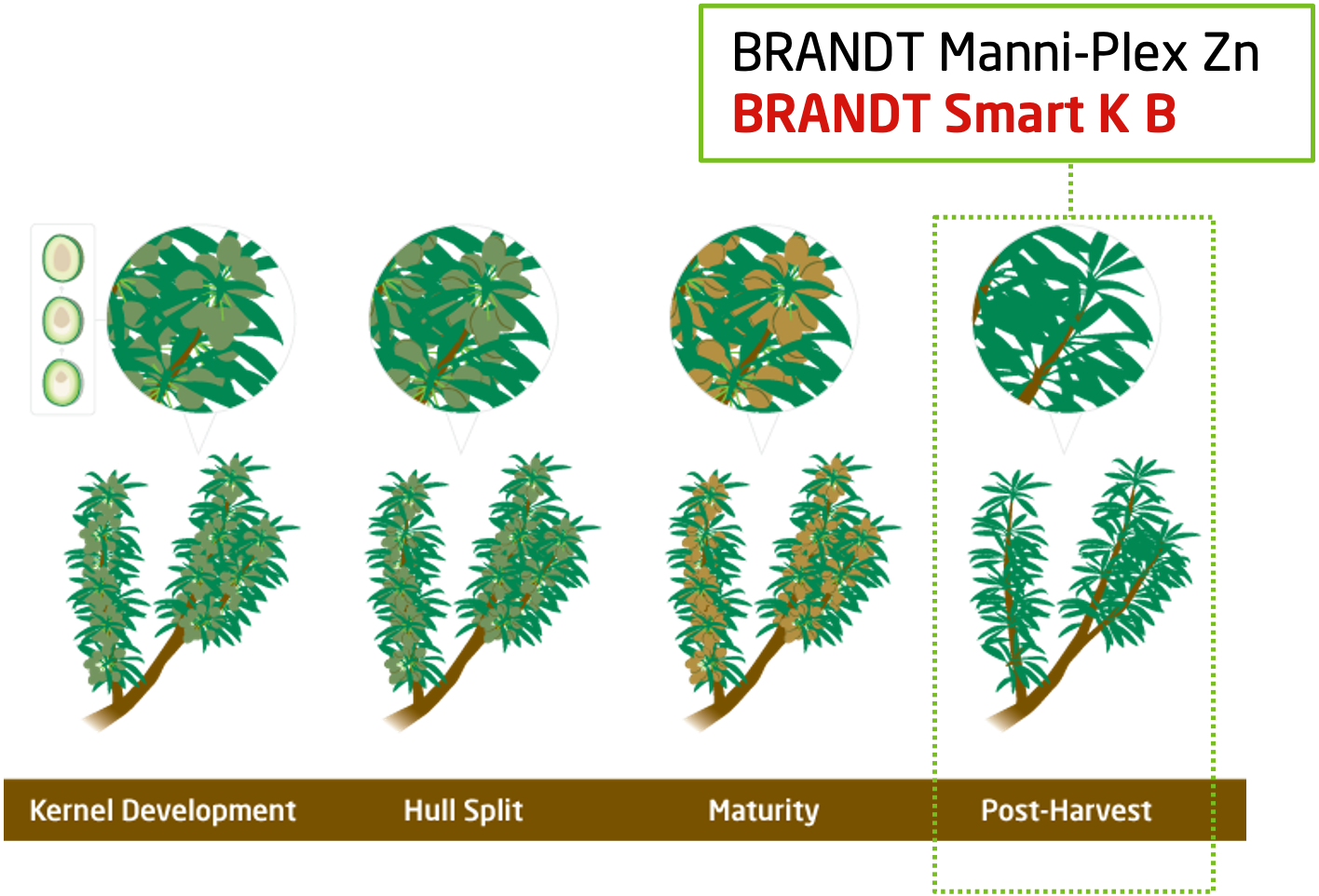
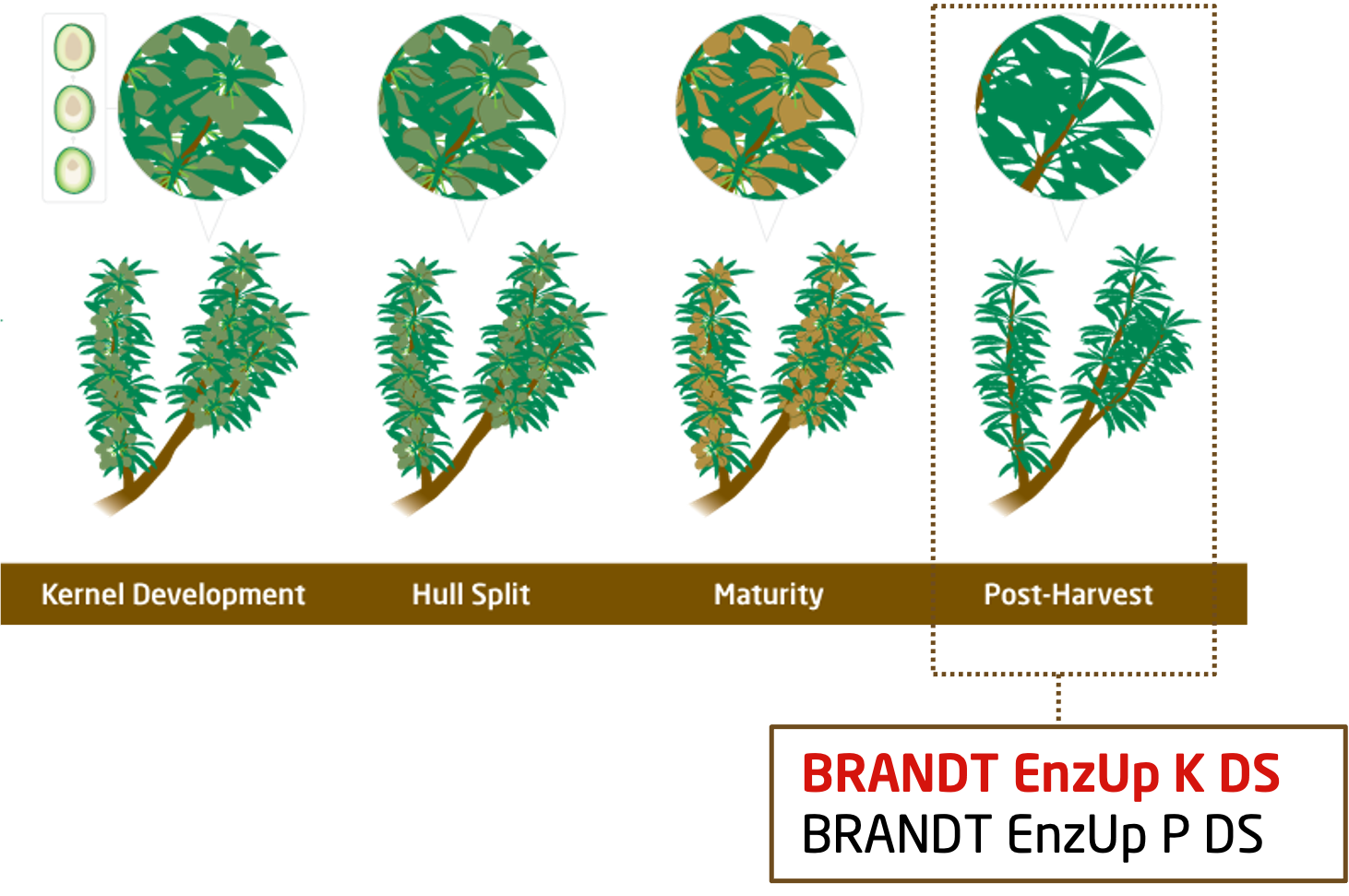
Bud Development (Fertigation)
Hull split through harvest, attention should be paid to managing irrigation and getting nuts picked up. After harvest, a post-harvest fertigation will help feed the fall root flush and get some nutrition into next season’s fruiting buds. Especially beneficial if your mid summer tissue K level was below 1.4%.
Foliar Products During Bud Development
- BRANDT EnzUp K DS 20-30 lb/a (5-0-49-8S)
- BRANDT EnzUp P DS 15-20 lb/a (12-58-0)
Questions?
If you have any questions at all about this information presented to you, BRANDT is always glad to help. Click or tap the button below to get in touch with a BRANDT expert.
Do you think BRANDT’s products are the right fit for your operation? Click or tap the button below to find a retailer that sells BRANDT products near you.
